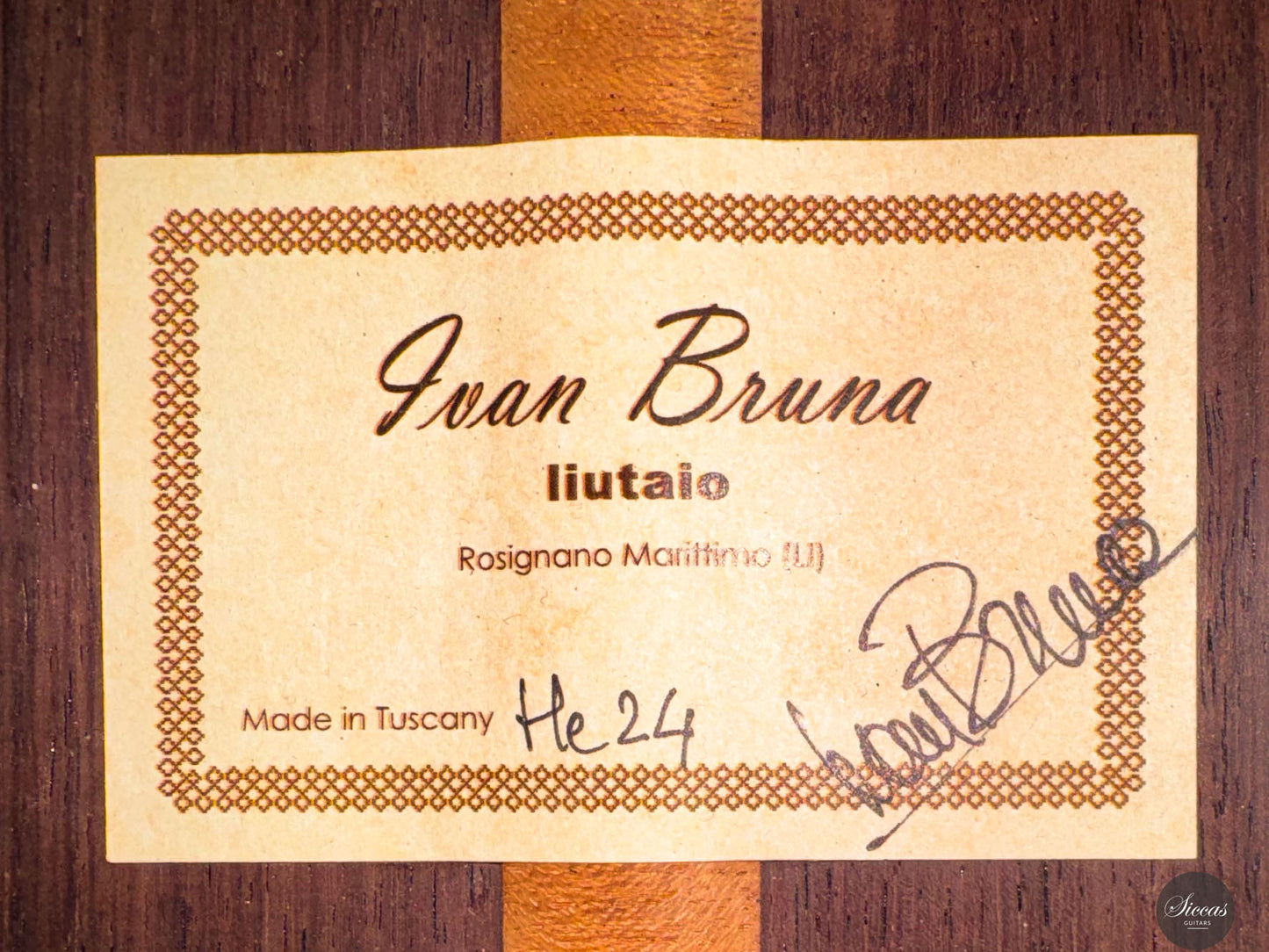Ivan Bruna - 2024
Ivan Bruna - 2024
Details
Details
Overview
Overview
Shipping important note
Shipping important note
Delivery times are typically reliable and most instruments arrive within the estimated timeframe.
Should any unexpected delay occur, our team will keep you informed and provide support at every step. For all shipping details and exceptions, please see our Shipping Policy.
Details about GPSR
Details about GPSR

























Video overview


More details about the guitar
About the luthier
Ivan Bruna is an Italian guitar maker based near Livorno, where he builds concert instruments entirely by hand in the classical tradition. After graduating from the Scuola di Liuteria di Milano, he completed a formative apprenticeship under master luthier Enrico Bottelli. Bruna's instruments reflect an analytical, sound-focused approach rooted in deep listening and precision. Rather than pursuing novelty for its own sake, he refines traditional methods to serve clarity, richness, and reliability. His guitars are known for their structural refinement, visual coherence, and a bold tonal core that maintains clarity across a wide dynamic range.
About the guitar
Completed in 2024, this traditionally built concert guitar showcases Ivan Bruna’s commitment to tone and detail. The top is made of master-grade spruce, paired with Indian rosewood back and sides, all under a warm French polish that enhances both texture and colour. With a scale of 640 mm and a 49 mm nut, the neck sits comfortably in the hand, shaped for fluid movement across the fingerboard.
Tonally, the guitar delivers a rich and saturated voice with impressive depth. Its heavy tonal weight gives every note presence and gravitas, while the upper register remains brilliant and clear. The air-body frequency sits around F♯/G, contributing to the warmth and resonance. Articulation is precise, and the sound blooms with a wealth of colour options, making it a highly versatile instrument for a wide variety of repertoire. Subtle visual flourishes in the purfling and rosette round out a guitar that is as sophisticated in sound as it is in appearance.
Condition
This instrument is in excellent condition with only minimal signs of play. It has no cracks or repairs and remains structurally and cosmetically well preserved.
Regular care extends the life of the instrument
Even with careful use, a classical guitar may gradually change in appearance or respond to unstable storage conditions. Have a close look at your guitar regularly and be attentif to changes. If your instrument is suffering from its environement, it will let you know.
Protect Your Guitar: Handle with Care
Be mindful when touching your instrument with greasy or unwashed hands: any skin contact is a small attack on the varnish. Of course, a guitar is made to be played, but taking a few precautions helps preserve its beauty: wash your hands before playing, wear long sleeves, and avoid unnecessary direct skin contact with the body of the instrument.
Pro tip: Avoid playing with a button-up shirt, heavy jewelry, or a belt, as these can scratch the guitar. Also, make sure your guitar case is free of any objects that could damage the instrument during storage.
String care
A good habit to adopt is wiping down your strings briefly after each playing session. This small action significantly extends their lifespan and helps maintain a consistent, comfortable feel under your fingers.
Most importantly, clean strings are essential for keeping your instrument in tune. Corrosion, sweat, and dust can affect the uniformity of the strings and interfere with accurate tuning across the entire fingerboard.
Pro tip: If you're having trouble getting your guitar in tune, it might be time to change the strings. A useful test is to compare the pitch of the 12th fret harmonic with the fretted note at the 12th fret; if there's an unusually large gap between them, your strings may have lost their integrity and should be replaced.
Keep Your Shellac Finish Shining!
Got a guitar with a shellac (French polish) finish? Here's a simple trick: Take a clean microfiber cloth and gently breathe on the surface to create a light mist. Then, softly rub to remove fingerprints, sweat, and grease. That’s usually all it takes to keep it looking great, no products needed!
Pro tip: Every few years, treat your guitar to a check-up with a luthier to keep it in top shape.
Storing Your Guitar: Climate Matters
Your guitar can safely stay outside its case, as long as the surrounding environment maintains 42–55% humidity and a temperature between 18–25°C.
Keep in mind that humidity levels can still fluctuate inside the case, especially during seasonal changes.
- Too much humidity may cause overtightened strings and a dull tone.
- Too little humidity can lead to a bulging top, string buzz, or even cracks.
Avoid placing your guitar near radiators, air conditioners, or windows with direct sunlight.
Pro tip: Always close your guitar case while playing. This helps preserve a stable microclimate inside the case, so your instrument is protected the moment you put it back in.





















































